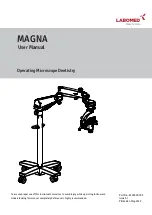
11
5 Usage
5.1 Size Selection
The Tübingen Hip Flexion Orthosis is available in 3 sizes. It is selected according to the age of
the infant (see sizing table).
5.2 Initial fitting
The fitting of the orthosis by qualified personnel is a key factor for good acceptance and success
ful treatment. The orthosis setting is symmetrical upon delivery. Individual size adjustment is only
possible while the orthosis is being worn.
INFORMATION
While putting on the orthosis for the first time, demonstrate the individual steps for the parents
using the included information for parents. The parents must only use the hook-and-loop closure
(2) and the white clamp closures (3) to put on and take off the orthosis.
Application
1) Open the hook-and-loop closure (2) and the white closures (3), and take the beaded cords (4)
out of the closures (3). Spread out the orthosis on the changing table. Position the thigh
shells (5) with the beaded cords (4) to the side of the child (see fig. 2).
2) Apply the shoulder harness (1) around the neck from behind and fasten it loosely on the chest
with the hook-and-loop closure (2).
INFORMATION: Ensure that a space of at least two finger widths is maintained
between the hook-and-loop closure (2) and the neck.
3) Grasp the legs by the lower legs and move them to hip flexion of more than 90° with abduc
tion. To maintain hip flexion, support the child’s feet on your abdomen or upper body. Place
the thighs into the thigh shells (see fig. 3).
4) Insert the beaded cords (4) into the white closures (3) (see fig. 4).
5) Fasten the white closures (3) (see fig. 5).
Adjusting the flexion position in the hip joint
The distance between the shoulder harness (1) and thigh shells (5) determines hip flexion and
can be adjusted using the front white closures (3) and the back red closures (8).
Ensure that the
hip joints are flexed in excess of 90°
(see fig. 6) and that the tension of the beaded cords (4) is
consistent.
1) If the hip joint is not flexed enough, shorten the beaded cords (4) on the front white closures
(3) so they are symmetrical. The green/white colour of the beads makes it easier to obtain a
symmetrical setting.
2) If an additional adjustment on the back red closures (8) is required, consult the section
“Adjusting the orthosis for growth”.
If the tension on the front and back sections of the beaded cords is different or the front hook-
and-loop closure (2) is too close to the neck, change the position as follows:
1) Open the lower closure (9) (see fig. 14).
2) Release the beaded cord (4) from the lower closure (9): hold the beaded cord with the middle
and index fingers, and pull to release the secured bead.
3) Slide the thigh shells along the beaded cord (4) until the distance between the shoulder har
ness (1) and the neck is two finger widths on all sides and the thigh shells (5) are evenly posi
tioned. The spreader bar (7) must lie symmetrically between the thighs.
4) Secure the beaded cord (4) in the lower closure (9): push the beaded cord into the bead
holder until the secured bead engages with audible feedback.
5) Fasten the lower closure (9).
Summary of Contents for 28L10
Page 2: ...1 2 3 4 5 2...
Page 3: ...30 45 90 6 7 8 9 10 11 3...
Page 73: ...73 3 3 1 28L10 1 3 2 1 IIa IIb IIc 3 3 3 4 1 3 5 90 5 1 2 4 7 4 4 1 4 2 1 1 1 2...
Page 82: ...82 3 4 T binger 1 3 5 90 T binger 5 1 2 4 7 4 4 1 4 2 1 1 1 2 8 9 7 5 5 1 T binger 3 5 2...
Page 85: ...85 7 8 8 1 8 2 8 3 CE 2017 745 1 2020 11 11 2 2 1 1 1 6 2 7 3 8...
Page 87: ...87 4 4 1 4 2 1 1 1 2 8 9 7 5 5 1 3 5 2 2 3 1 2 3 4 3 5 4 2...
Page 89: ...89 8 1 1 4 8 2 4 3 4 8 12 4 90 13 5 4 2 3 1 2 3 2 4 6 1 2 1 2 15 2 1 3 2 40 C 4 5 1 2 7 8...
Page 90: ...90 8 1 8 2 8 3 2017 745 CE 1 2020 11 11 2 2 1 1 1 6 2 7 3 8 4 9 5 2 1 2 2 5 1 3 8 9 1 2 3...
Page 98: ...98 8 2 8 3 CE 2017 745 CE...
Page 99: ...99...
Page 100: ...100...
Page 101: ...101...












































